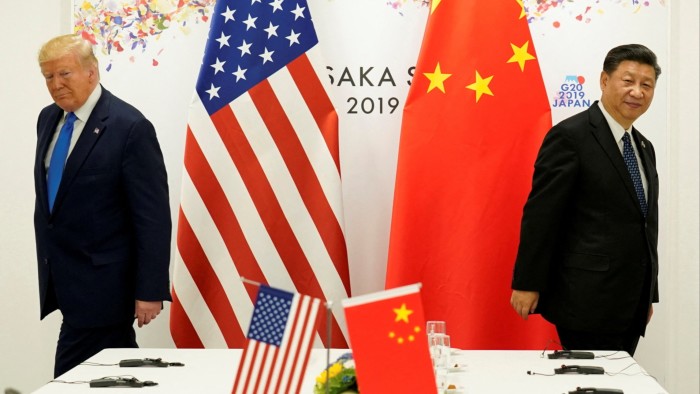
China has expressed strong disapproval of the recent US-Vietnam trade agreement, raising concerns in Beijing that President Donald Trump’s “liberation day” tariff negotiations with third countries are a strategic move to limit China’s export capabilities. The deal, announced on Wednesday, reduces tariffs on Vietnamese exports from a threatened 46 percent to 20 percent, but maintains a 40 percent levy on “trans-shipping” of goods, which is widely believed to target Chinese re-exports to the US.
The announcement comes as the second agreement perceived to be aimed at China since Trump unveiled his “liberation day” tariff increases on April 2. Earlier in May, the US and UK reached a deal imposing strict security requirements on steel and pharmaceuticals, seen as a measure to exclude China from British supply chains. On Thursday, China’s commerce ministry stated it was “conducting an assessment” of the US-Vietnam trade deal, emphasizing, “We firmly oppose any party striking a deal at the expense of China’s interests.”
Implications for Global Trade Dynamics
Scores of countries are racing to finalize trade agreements with the US before the July 9 deadline, when Trump’s suspended “reciprocal” tariffs are set to take effect. Vietnam, one of the world’s most trade-dependent nations, had a strong incentive to act swiftly to avoid US tariffs, as the US accounts for 30 percent of its exports. However, the final tariffs agreed upon, along with the additional levy on trans-shipping, reflect a significant cost for Hanoi to secure the deal, according to analysts.
“The new US-Vietnam deal is not just about trade; it is clearly aimed at China,” said Julien Chaisse, an expert on international economic law at the City University of Hong Kong. “It is meant to block the flow of Chinese goods that often move through Vietnam to dodge existing US duties.”
Strategic Moves in Southeast Asia
This development follows a broader trend where the US is establishing bilateral deals with countries near China to strengthen economic cooperation while making it more challenging for Beijing to extend its supply chain influence. Many Southeast Asian nations have thrived during the US-China trade war by offering alternative manufacturing and export hubs for Chinese companies seeking to evade US tariffs. However, capitalizing on this “China plus one” strategy has resulted in large trade surpluses in goods with the US.
“The key lesson for other countries from this deal, and that agreed previously by the UK, is that they will be expected to curtail some trade with China,” noted Capital Economics’ chief Asia economist Mark Williams and senior Asia economist Gareth Leather in a note. “That will be seen as a provocation in Beijing, particularly if similar conditions are included in any other deals agreed over coming days.”
Potential Impact on US-China Relations
Analysts warn that the Vietnam deal, along with others perceived by Beijing as threatening its interests, could jeopardize US-China trade discussions. Trump recently claimed a tariff truce with Beijing had been signed, yet concerns persist over Chinese restrictions on rare-earth exports and US export controls on advanced technology such as semiconductors.
“This could certainly lead to a renewed escalation of US-China trade tensions if the US insists on very stringent restrictions by third parties on imports from China,” said Frederic Neumann, chief Asia economist at HSBC.
Challenges in Enforcing Trade Measures
Adam Sitkoff, executive director of the American Chamber of Commerce in Hanoi, remarked that it was a positive sign for Vietnam to secure a deal before the deadline, avoiding the predicament faced by countries like Japan, which Trump again threatened with higher tariffs this week. Key for Hanoi will be how the 40 percent trans-shipment levy is enforced. Trans-shipment is notoriously difficult to trace, and the Trump administration has not clarified how it defines the practice, although it has prioritized the issue in trade talks with Vietnam and other Southeast Asian countries.
Brian Wong, a professor at Hong Kong University, commented that Chinese officials are aware of the challenges the US would face in enforcing trans-shipment measures, given the complexity of global trade and the ease with which companies can navigate around regulations. “The devil lies in the details of enforcement as opposed to the agreements,” Wong stated, adding that Beijing’s outraged rhetoric was mainly “performative.”
Uncertainties and Future Prospects
For Vietnam, Sitkoff noted that many details of the deal remain ambiguous, such as whether the 20 percent tariff is a final figure or if it will be applied on top of existing levies, as well as which products will be subject to the 40 percent charge. “Assessing the pros and cons of the deal is difficult without seeing further details about what the tariffs actually mean,” he said.
“Do the 40 percent tariffs on ‘trans-shipped’ goods apply to any product that contains content from another nation? The answers to these questions can be the difference between celebrating or crying.”
As the July 9 deadline approaches, the global trade landscape watches closely to see how these developments will unfold and what implications they will have for international economic relations and the ongoing US-China trade tensions.







